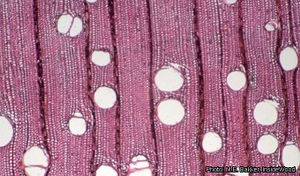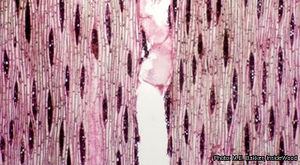Dacryodes igaganga (PROTA)
Introduction |
| General importance | |
| Geographic coverage Africa | |
| Geographic coverage World | |
| Fruit | |
| Timber | |
| Fibre | |
| Food security | |
| Conservation status | |
Dacryodes igaganga Aubrév. & Pellegr.
- Protologue: Fl. Gabon 3: 86 (1962).
- Family: Burseraceae
Origin and geographic distribution
Dacryodes igaganga occurs in Cameroon, Equatorial Guinea, Gabon and possibly Congo.
Uses
The wood (trade name: igaganga) is used for veneer, plywood, joinery and parquetry. It is also suitable for construction, furniture and cabinet work, vehicle bodies, ship and boat building, handles, ladders, carvings, toys, novelties, turnery, poles and piles. It can be used for paper making. The fruit pulp is edible.
Production and international trade
The wood is very similar to ‘ozigo’ (wood of Dacryodes buettneri (Engl.) H.J.Lam) and ‘ossabel’ (wood of Dacryodes normandii Aubrév. & Pellegr.), and it is often sold together with the latter. Exports of igaganga from Gabon are diminishing: 32,690 m³ in 2000, 13,350 m³ in 2001, 8360 m³ in 2002, 9500 m³ in 2003, 7800 m³ in 2004 and 2630 m³ in 2005.
Properties
The heartwood is pale brown or pink; it is not distinctly demarcated from the 2–4 cm wide cream-coloured sapwood. The grain is straight or interlocked; the texture fine to medium. The wood contains silica.
The wood has a density of 580–670 kg/m³ at 12% moisture content. It dries rapidly and generally without problems. The rates of shrinkage from green to oven dry are 3.8–6.2% radial and 6.8–9.6% tangential. Once dry, the wood is stable in service. At 12% moisture content, the modulus of rupture is 95–155 N/mm², modulus of elasticity 9600–13,100 N/mm², compression parallel to grain 52–67 N/mm², shear 8–12 N/mm², cleavage 14–25 N/mm and Chalais-Meudon side hardness 2.5–4.7.
Sawing is rather difficult due to the presence of silica, causing severe blunting of tools; stellite saw teeth and tungsten carbide tools are recommended. The wood finishes, nails, screws and glues well. Peeling and slicing properties are good. The wood is not very durable, being susceptible to attack by fungi, termites, dry-wood borers and marine borers. The heartwood is resistant to impregnation.
The fruit contains an essential oil, the main components of which are α-copaene (16%) and α-humulene (14%).
Description
- Dioecious, medium-sized tree up to 25 m tall; bole straight, cylindrical, branchless for up to 15 m, up to 90 cm in diameter; outer bark grey, flaking, inner bark brownish pink, fibrous, slightly fragrant, when cut exuding small amounts of a resin becoming amber-coloured on hardening.
- Leaves alternate, imparipinnately compound with 5–7 pairs of leaflets; stipules absent; petiole plano-convex, rachis scaly; petiolules c. 5 mm long; leaflets opposite, narrowly oblong to lanceolate, 7–11(–15) cm × 2.5–4 cm, base asymmetric, apex acuminate, lower surface slightly hairy or glabrous, pinnately veined with 8–10 pairs of lateral veins.
- Inflorescence a panicle 12–15 cm long, reddish brown hairy.
- Flowers unisexual, regular; male flowers with pedicel 1.5 mm long, sepals 3, c. 3 mm long, hairy outside, glabrous inside, petals 3, hairy outside, covered with glandular hairs inside, stamens 6, with glandular hairs.
- Fruit an ellipsoid drupe, blue-black at maturity, stone ellipsoid, flattened, c. 3 cm × 2 cm × 1.5 cm, hard, with rough surface, 1-seeded.
Other botanical information
Dacryodes comprises about 40 species, occurring in the American, Asian and African tropics. In Africa, about 20 species have been found, all of section Pachylobus. Gabon seems richest with approximately 10 species.
Ecology
Dacryodes igaganga occurs in lowland rainforest up to 550 m altitude.
Management
Treatment of the logs with preservatives after felling is recommended.
Genetic resources
Dacryodes igaganga is classified as vulnerable in the 2007 IUCN Red list of threatened species, due to the rate of logging that has taken place and general habitat decline.
Prospects
Because of overexploitation in the past, Dacryodes igaganga has become vulnerable. Therefore, its use should only be allowed where sustainable exploitation takes place.
Major references
- Aubréville, A., 1962. Burséracées. Flore du Gabon. Volume 3. Muséum National d’Histoire Naturelle, Paris, France. pp. 53–95.
- CIRAD Forestry Department, 2003. Igaganga. [Internet] Tropix 5.0. http://tropix.cirad.fr/afr/igaganga.pdf. December 2007.
- Normand, D. & Mariaux, A., 1962. Peut-on distinguer les bois d’ozigo, des safoukala, igaganga et autres Dacryodes? Bois et Forêts des Tropiques 85: 33–40.
- Takahashi, A., 1978. Compilation of data on the mechanical properties of foreign woods (part 3) Africa. Shimane University, Matsue, Japan, 248 pp.
- Vivien, J. & Faure, J.J., 1985. Arbres des forêts denses d’Afrique Centrale. Agence de Coopération Culturelle et Technique, Paris, France. 565 pp.
Other references
- ATIBT (Association Technique Internationale des Bois Tropicaux), 2005. Statistics. ATIBT Newsletter 22: 26–47.
- Bolza, E. & Keating, W.G., 1972. African timbers: the properties, uses and characteristics of 700 species. Division of Building Research, CSIRO, Melbourne, Australia. 710 pp.
- Cravo, L., Perineau, F., Delmas, M. & Bessiere, J.M., 1992. Volatiles of the fruit of Dacryodes buettneri H.J. Lam and D. igaganga Aubrev. et Pellegr. (Burseraceae). Journal of Essential Oil Research 4(1): 95–96.
- Daly, D.C. & Martínez-Habibe, M.C., 2002. Notes on Dacryodes Vahl, including a new species from the Rio Negro basin in Amazonia. Studies in neotropical Burseraceae. XI. Brittonia 54(4): 266–274.
- de Saint-Aubin, G., 1963. La forêt du Gabon. Publication No 21 du Centre Technique Forestier Tropical, Nogent-sur-Marne, France. 208 pp.
- Oxford Forestry Institute, 1997–2004. Prospect: the wood database for Windows. Version 2.1. [Internet] University of Oxford, Oxford, United Kingdom. http://www.plants.ox.ac.uk/ofi/prospect/index.htm. December 2007.
- Parant, B., Boyer, F., Chichignoud, M. & Curie, P., 2008. Présentation graphique des caractères technologiques des principaux bois tropicaux. Tome 1. Bois d’Afrique. Réédition. CIRAD-Forêt, Montpellier, France. 186 pp.
- Sallenave, P., 1971. Propriétés physiques et mecaniques des bois tropicaux. Deuxième supplément. Centre Technique Forestier Tropical, Nogent-sur-Marne, France. 128 pp.
- Vivien, J. & Faure, J.J., 1988. Fruitiers sauvages du Cameroun. Fruits Paris 43(9): 507–516.
- World Conservation Monitoring Centre, 1998. Dacryodes igaganga. In: IUCN. 2007 IUCN Red list of threatened species. [Internet] http://www.iucnredlist.org. December 2007.
Author(s)
- M. Brink, PROTA Network Office Europe, Wageningen University, P.O. Box 341, 6700 AH Wageningen, Netherlands
Correct citation of this article
Brink, M., 2008. Dacryodes igaganga Aubrév. & Pellegr. In: Louppe, D., Oteng-Amoako, A.A. & Brink, M. (Editors). PROTA (Plant Resources of Tropical Africa / Ressources végétales de l’Afrique tropicale), Wageningen, Netherlands. Accessed 31 March 2025.
- See the Prota4U database.


